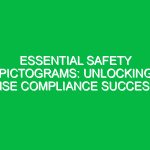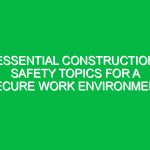Introduction to Our Toolbox Talk
Good morning, team! Today, we’re conducting a Toolbox Talk focused on an essential piece of Personal Protective Equipment (PPE) that plays a critical role in our everyday Safety: Safety Glasses. As we prepare to start our day’s work, it’s vital to understand why using Safety Glasses is not just a recommendation but a necessity in our line of work. This discussion will cover the importance of Safety glasses, their proper use, potential Hazards, and Best Practices to ensure we maintain a safe working Environment. Let’s dive in!
The Importance of Safety Glasses in HSE
Every one of us is responsible for maintaining a safe workplace, and wearing Safety Glasses is a fundamental part of that responsibility. According to the Occupational Safety and Health Administration (OSHA), eye injuries are among the most common workplace injuries, accounting for thousands of incidents each year. These injuries can lead to extensive medical bills, lost time from work, and even permanent vision impairment.
By wearing safety glasses, we significantly reduce the risk of eye injuries from flying particles, chemical splashes, or harmful radiation. Remember, our eyes are irreplaceable; once damaged, they cannot be healed. Protecting them should always be a top priority.
Types of Safety Glasses
When it comes to Safety Glasses, understanding the different types can help us choose the right pair for specific tasks. Here are the most common types:
- Basic Safety Glasses: These are designed to protect against flying debris and small particles.
- Goggles: These provide a tighter seal around the eyes and are essential for protection against splashes or chemicals.
- Face Shields: These protect the entire face and are often used in conjunction with safety glasses for added protection.
- Prescription Safety Glasses: For those who need vision correction, these glasses are made with safety-rated lenses.
- Specialty Glasses: These include options for welding, laser protection, or other specific Hazards.
Potential Hazards and Risks
Understanding the hazards we face is crucial for selecting the appropriate safety glasses. Here are some common scenarios where eye injuries can occur:
- Flying Debris: During tasks like grinding, cutting, or machining, small particles can fly into the eyes.
- Chemical Exposure: In environments where chemicals are handled, splashes can cause serious damage to the eyes.
- Radiation: Activities like welding or working with UV light sources can damage the eyes without proper protection.
In each of these cases, having the right type of Safety Glasses can mean the difference between an injury and a safe workday. Always assess the risks associated with your tasks and wear the appropriate Eye Protection.
Best Practices for Using Safety Glasses
To maximize the effectiveness of Safety Glasses, follow these Best Practices:
- Choose the Right Glasses: Always select safety glasses that are appropriate for the task at hand.
- Ensure a Proper Fit: Safety glasses should fit snugly but comfortably without obstructing your vision.
- Regularly Inspect Your Glasses: Check for scratches, cracks, or other damage before each use.
- Keep Them Clean: Use a soft cloth and appropriate cleaner to maintain clear visibility.
- Store Properly: When not in use, store safety glasses in a protective case to avoid scratches and damage.
Real-Life Scenarios: The Importance of Safety Glasses
Let’s take a moment to consider some real-life scenarios that illustrate the critical nature of wearing Safety Glasses. Imagine a worker cutting metal without eye protection. Suddenly, a small shard flies towards their face. If they were wearing safety glasses, the glasses would absorb the impact, potentially saving their vision. Conversely, without them, that shard could lead to a serious injury, resulting in medical emergencies and lost work time.
In another scenario, consider a situation where chemicals are being handled. A splash could easily reach the eyes, causing severe damage. Wearing appropriate Safety Goggles would eliminate this risk, protecting the worker from harmful exposure.
Compliance with Regulations and Standards
As part of our commitment to health and safety, it’s crucial to comply with regulations related to Safety Glasses. osha mandates that employers provide appropriate PPE, including safety glasses, to protect employees from recognized hazards. Additionally, ANSI Z87.1 is a standard that specifies the requirements for safety glasses. Compliance with these regulations not only keeps us safe but also ensures that we meet legal obligations.
Engaging Our Team in Safety Practices
As we wrap up this Toolbox Talk, I want to encourage everyone to actively engage in safety practices. Ask yourself:
- Are you consistently wearing your safety glasses on the job?
- Do you understand the specific hazards associated with your tasks?
- Have you checked your safety glasses for damage today?
These questions are not just formalities; they’re essential for fostering a culture of safety. Each of us plays a critical role in maintaining a safe work environment. If you notice a colleague not wearing their safety glasses, speak up! Safety is a shared responsibility.
Conclusion: Reiterating the Importance of Safety Glasses
In conclusion, today’s Toolbox Talk has highlighted the importance of Safety Glasses in preventing workplace injuries. By understanding the types of safety glasses, recognizing potential hazards, and adhering to best practices, we can protect our most valuable asset—our eyesight. Remember, safety glasses are not just an accessory; they are a vital component of our Safety Gear.
Thank you for your attention and commitment to making our workplace safer. Let’s all make a concerted effort to wear our safety glasses at all times while on the job. Together, we can create a safe working environment for everyone!


